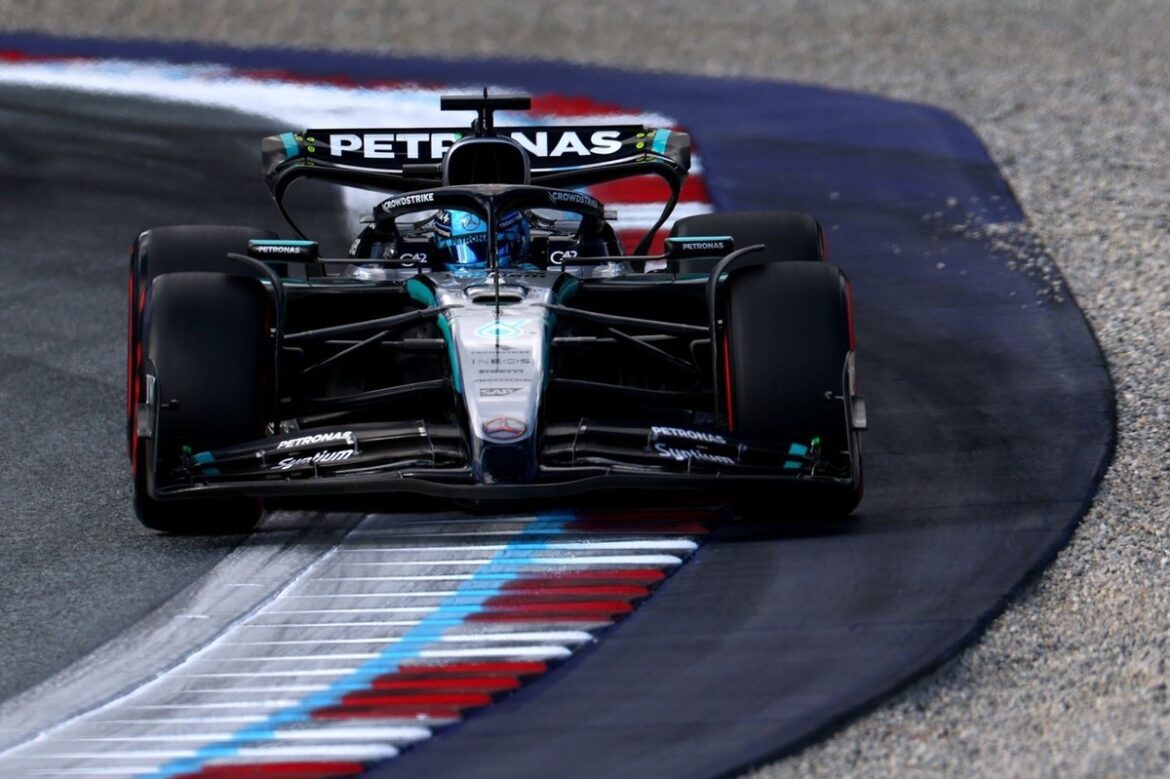Mercedes Faces Challenges at the Austrian Grand Prix: A Detailed Analysis
The Austrian Grand Prix marked a challenging weekend for Mercedes, as George Russell finished in fifth place, trailing the dominant McLaren team by over a minute. This outcome was particularly disappointing considering the team’s recent victory at the Canadian Grand Prix, where they had hoped to maintain momentum. The searing conditions at the Red Bull Ring highlighted significant issues, particularly with tyre overheating, which had also impacted their performance in previous hot races in Jeddah and Imola.
Tyre Overheating: A Persistent Challenge
Mercedes entered the Austrian race weekend with high expectations, but instead faced one of their most disappointing performances of the season. Russell’s time on the track revealed a glaring problem: the W16’s struggle with tyre overheating. Despite the team’s efforts over the past six months to address this issue, they have yet to make substantial progress. "I was expecting a bad race and it was worse than I could have imagined," Russell commented post-race. The driver noted that the car performed well in cooler conditions, but once the temperature rose, the performance dropped significantly.
Interestingly, the asphalt temperature during the Canadian GP had also reached 50°C, yet Mercedes managed to secure a win without significant tyre issues. In Austria, however, the combination of track layout and temperature exacerbated their struggles. The team found themselves not only behind McLaren but also unable to compete effectively with Ferrari, who finished significantly ahead after introducing performance upgrades.
The Track Layout: An Additional Complication
The layout of the Red Bull Ring played a crucial role in the challenges faced by Mercedes. The circuit consists of two distinct sectors; one features heavy braking zones mixed with long straights, while the other consists of fast corners that put a considerable strain on the tyres. This setup increases the risk of overheating, putting additional pressure on the W16’s performance.
During qualifying, Mercedes showed promise, maintaining competitive speeds on both the straights and in braking zones. However, in the longer corners, particularly at Turn 9, it became clear that they were struggling compared to their rivals. This disconnect was unexpected, especially given their previous performances on similarly fast tracks where they had managed to compete more closely with the frontrunners.
The Misalignment of Strategies
Mercedes team principal Toto Wolff indicated that the team’s strategy might have been misaligned with the conditions in Austria. They had based their setup on successful outcomes from the Canadian GP, which may have led to incorrect assumptions about performance in Austria. “We felt like there was a direction we wanted to go, which was perfectly logical for Canada, but a little bit counterintuitive for Austria,” Wolff explained.
This misjudgment became apparent as the temperatures rose significantly from Friday to Sunday, which led to an increase in grip that the team was not prepared for. Their inability to adjust effectively to the changing conditions caused a considerable decline in performance, resulting in a race that was far from what they had anticipated.
The Impact of Track Conditions
The Austrian GP presented one of the most abrasive track surfaces of the season, which only compounded Mercedes’ problems. The high-speed nature of the circuit, coupled with soaring temperatures, created a "perfect storm" for the W16. Russell remarked on this harsh reality, emphasizing that the combination of high temperatures and rough asphalt made it particularly challenging for their car.
The overheating tyres not only compromised their speed but also affected their traction, leading to a cascading effect on their overall race strategy. With insufficient grip, Mercedes found it increasingly difficult to mount any significant challenges against their competitors.
Experimental Setups and Future Considerations
Wolff also disclosed that Mercedes had opted to test some experimental setups in Austria with an eye towards future developments, including considerations for the 2026 season. While this approach was intended to yield innovative solutions, the results in Austria were disappointing. “The only positive thing I take away from this weekend is that we tried something extreme: in Montreal it worked, here it didn’t,” Wolff stated.
He acknowledged that reverting to last year’s setup might have yielded a better outcome, perhaps even a podium finish. This experimentation underscores the balancing act teams must perform between innovation and reliability, particularly when facing challenging conditions.
The Road Ahead for Mercedes
Looking ahead, Mercedes recognizes that they must refine their approach, especially concerning tyre management and track-specific setups. The challenges faced at the Austrian Grand Prix serve as a stark reminder of the complexities involved in Formula 1 racing, where even minor miscalculations can lead to significant performance setbacks.
As the season progresses, the team will need to analyze data from Austria thoroughly to identify the most effective strategies moving forward. They will also need to continue developing the car to better handle varying track conditions, particularly in hot weather.
Conclusion: A Learning Experience
The Austrian GP was undoubtedly a tough weekend for Mercedes, but it also offered valuable lessons that can be applied to future races. The combination of overheating issues, track layout, and strategic misalignments highlighted areas where improvement is necessary. As the team works to enhance their performance, fans and analysts alike will be keenly watching how they adapt and respond in the upcoming races.
Mercedes’ journey in Formula 1 is marked by resilience and determination, and though this race may have been a setback, it is also an opportunity for growth and development. As they look to the future, the team must harness the insights gained from this experience to ensure they remain competitive in the high-stakes world of Formula 1 racing.
